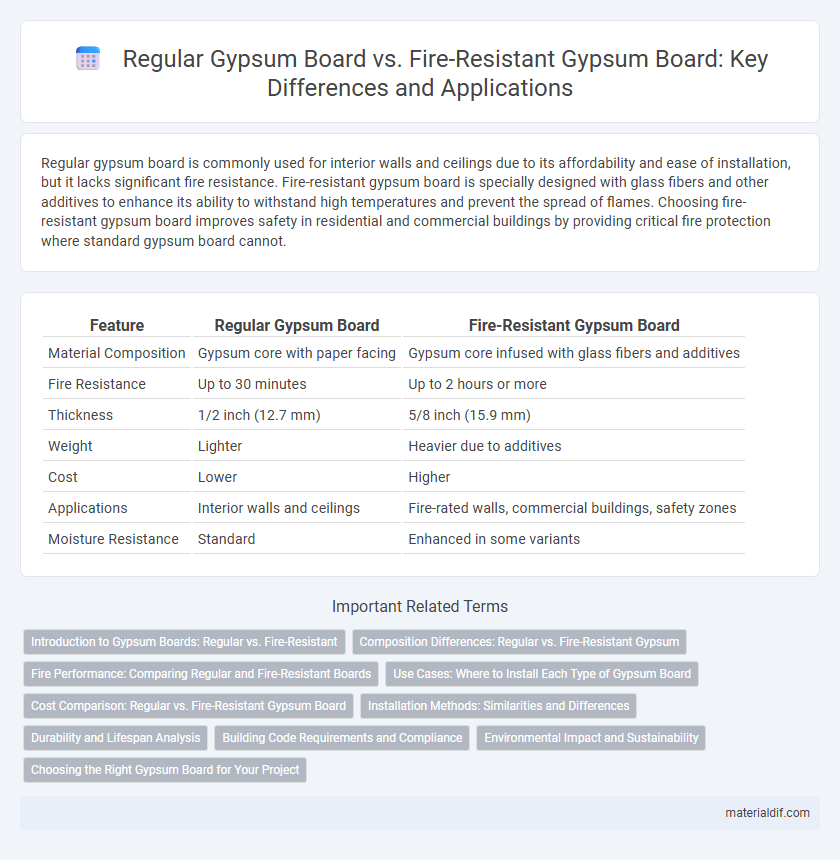Regular gypsum board is commonly used for interior walls and ceilings due to its affordability and ease of installation, but it lacks significant fire resistance. Fire-resistant gypsum board is specially designed with glass fibers and other additives to enhance its ability to withstand high temperatures and prevent the spread of flames. Choosing fire-resistant gypsum board improves safety in residential and commercial buildings by providing critical fire protection where standard gypsum board cannot.
Table of Comparison
| Feature | Regular Gypsum Board | Fire-Resistant Gypsum Board |
|---|---|---|
| Material Composition | Gypsum core with paper facing | Gypsum core infused with glass fibers and additives |
| Fire Resistance | Up to 30 minutes | Up to 2 hours or more |
| Thickness | 1/2 inch (12.7 mm) | 5/8 inch (15.9 mm) |
| Weight | Lighter | Heavier due to additives |
| Cost | Lower | Higher |
| Applications | Interior walls and ceilings | Fire-rated walls, commercial buildings, safety zones |
| Moisture Resistance | Standard | Enhanced in some variants |
Introduction to Gypsum Boards: Regular vs. Fire-Resistant
Regular gypsum boards consist of a gypsum core sandwiched between paper facings, providing standard fire resistance and sound attenuation ideal for typical interior walls and ceilings. Fire-resistant gypsum boards incorporate fiberglass additives and denser cores to enhance fire protection, meeting stringent building codes for areas requiring higher fire ratings. Both types serve as essential materials in construction, with fire-resistant boards specifically designed to slow heat transfer and maintain structural integrity during fire exposure.
Composition Differences: Regular vs. Fire-Resistant Gypsum
Regular gypsum board consists primarily of a gypsum core sandwiched between two layers of paper, offering standard fire resistance suitable for typical interior applications. Fire-resistant gypsum board incorporates additives such as glass fibers and non-combustible minerals within the gypsum core to enhance its ability to withstand high temperatures and slow fire spread. The paper facings on fire-resistant boards are often treated with fire-retardant chemicals, further elevating their performance compared to regular gypsum board.
Fire Performance: Comparing Regular and Fire-Resistant Boards
Fire-resistant gypsum boards contain non-combustible additives like glass fibers, which significantly enhance their fire performance by delaying heat transfer and preventing flame penetration for up to one hour or more. Regular gypsum boards lack these fire-retardant components, resulting in lower fire resistance and faster structural failure during exposure to high temperatures. Building codes often require fire-resistant boards in areas with strict fire safety regulations due to their superior ability to protect occupants and structural integrity.
Use Cases: Where to Install Each Type of Gypsum Board
Regular gypsum board is ideal for interior walls and ceilings in residential and commercial spaces where fire resistance is not a primary concern, such as living rooms, bedrooms, and offices. Fire-resistant gypsum board is specifically designed for areas requiring enhanced fire protection, including stairwells, utility rooms, and between garages and living spaces to slow the spread of flames. Building codes often mandate fire-resistant gypsum board in locations with higher fire risk to ensure occupant safety and structural integrity.
Cost Comparison: Regular vs. Fire-Resistant Gypsum Board
Regular gypsum board generally costs less, averaging $0.30 to $0.50 per square foot, while fire-resistant gypsum board ranges from $0.60 to $1.50 per square foot due to added materials like glass fibers and chemical additives. Fire-resistant gypsum boards provide enhanced safety and building code compliance, justifying the higher investment in projects requiring fire ratings. Cost differences vary based on thickness, brand, and regional pricing, making budgeting essential for fire-rated installations.
Installation Methods: Similarities and Differences
Regular gypsum board and fire-resistant gypsum board share similar installation methods, including fastening with screws or nails to metal or wood studs and applying joint compound over taped seams. Fire-resistant gypsum board often requires specific spacing guidelines and may involve using moisture-resistant or mold-resistant variants within the fire-rated assemblies to enhance performance. Differences also include the need for fire-resistant boards to comply with building codes that mandate precise installation techniques to maintain fire ratings.
Durability and Lifespan Analysis
Regular gypsum board typically offers moderate durability with a lifespan averaging 10 to 15 years under normal indoor conditions. Fire-resistant gypsum board incorporates glass fibers and additives, enhancing its structural integrity and extending its lifespan beyond 20 years, especially in fire-prone or high-moisture environments. The increased density and specialized composition of fire-resistant boards contribute to superior resistance against heat, impact, and wear compared to standard gypsum panels.
Building Code Requirements and Compliance
Regular gypsum board meets basic building code requirements for interior walls and ceilings but lacks the enhanced fire resistance necessary in specific applications. Fire-resistant gypsum board is engineered to comply with stringent fire safety standards, providing increased fire protection that aligns with building codes for fire-rated assemblies in commercial and multi-family buildings. Compliance with local building codes mandates the use of fire-resistant gypsum board in areas requiring fire separation or rated walls to ensure occupant safety and structural integrity.
Environmental Impact and Sustainability
Regular gypsum board is primarily composed of calcium sulfate dihydrate, offering moderate environmental benefits due to its recyclable nature and abundant raw materials. Fire-resistant gypsum board incorporates additives such as glass fibers and chemical retardants, which can increase its environmental footprint by complicating recycling processes and introducing non-biodegradable substances. Sustainability assessments favor regular gypsum board for its simpler composition and lower embodied energy, while fire-resistant variants prioritize safety at the expense of higher environmental impact.
Choosing the Right Gypsum Board for Your Project
Regular gypsum board offers excellent soundproofing and moisture resistance, making it ideal for interior walls and ceilings in residential spaces. Fire-resistant gypsum board contains glass fibers and non-combustible additives, enhancing its ability to withstand high temperatures and slow fire spread, which is crucial for commercial buildings and fire-rated assemblies. Selecting the right gypsum board depends on project requirements, such as fire safety codes, durability needs, and environmental conditions to ensure optimal performance and compliance.
Regular gypsum board vs Fire-resistant gypsum board Infographic

 materialdif.com
materialdif.com